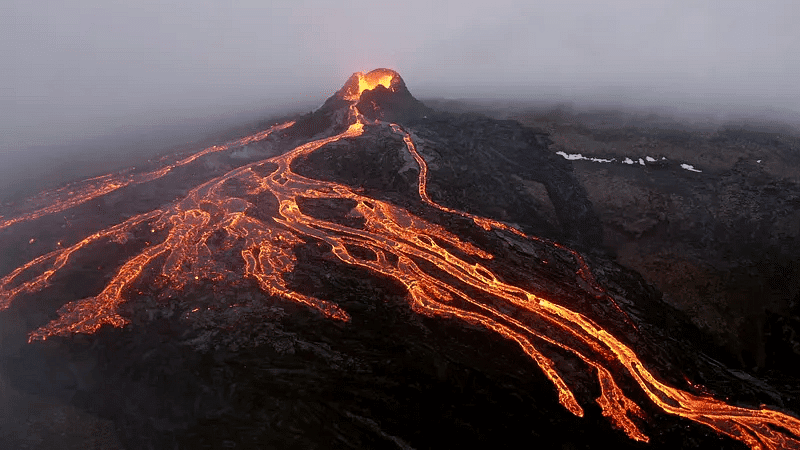Natural Hazards & their Mitigations- 1 | People, Development and Environment for UGC NET PDF Download
| Table of contents |

|
| Natural Hazards and their Mitigations |

|
| Earthquake |

|
| Tsunamis |

|
| Volcanoes |

|
Natural Hazards and their Mitigations
Natural hazards are occurrences in the environment that are caused by natural processes. These can be either rapid or slow in onset.
These hazards encompass various categories, including geophysical events like earthquakes, landslides, tsunamis, and volcanic activities.
 Natural Hazards
Natural Hazards
- Hydrological hazards such as avalanches and floods are also part of natural disasters.
- Climatological hazards like extreme temperatures, droughts, and wildfires are significant threats as well.
- These events pose dangers to both human populations and the surrounding environment.
Different types of natural hazards and their mitigation
Earthquake
Earthquakes are sudden releases of energy stored in deformed rocks within the Earth's crust, leading to ground tremors.
They can strike unexpectedly, resulting in significant loss of life and property. Causes include volcanic eruptions, faulting, folding, and man-made water bodies' hydrostatic pressure. Earthquake
Earthquake
Mitigation strategies for Earthquakes:
- Adherence to specific building codes and guidelines ensures safe construction practices to withstand earthquakes.
- Architectural and Engineering Inputs for Enhanced Building Design and Construction: Combining architectural and engineering expertise is crucial for enhancing building design and construction practices.
- Public Education on Earthquake Causes and Characteristics: It is important to educate the general public about the causes and characteristics of earthquakes to raise awareness.
- Mitigating Natural Disasters through Preparedness Measures: Implementing preparedness measures can help to some extent in reducing the impact of natural disasters like earthquakes.
Earthquake-Prone Areas in India
Least Damage Risk (Zone I)
- This zone encompasses parts of Punjab and Haryana, plain regions of Uttar Pradesh, sections of North Bihar and West Bengal, delta areas of Godavari, coastal plains in Maharashtra and Kerala, desert regions in Rajasthan, and most areas of Gujarat excluding Kutch region.
Low Damage Risk (Zone II)
- This zone covers Southern Punjab and Haryana, as well as the southern parts of the plains of Uttar Pradesh, Eastern Rajasthan, coastal districts of Odisha, and Tamil Nadu.
Moderate Damage Risk (Zone III)
- This zone includes Southern and South-Eastern Rajasthan, most of Madhya Pradesh, Maharashtra, and Karnataka, Southern Bihar, Northern and North-Western Odisha.
High Damage Risk (Zone IV)
- This zone comprises Jammu and Kashmir, Himachal Pradesh, Northern Punjab and Haryana, Delhi, Western Uttar Pradesh, terai and bhabar regions, and Himalayan regions of Uttarakhand, Bihar, and Sikkim.
Very High Damage Risk (Zone V)
- This zone includes parts of Jammu and Kashmir, some parts of Himachal Pradesh, Uttarakhand, extreme North Bihar, entire North Eastern India, and the Kutch region of Gujarat.
Tsunamis
Tsunamis are caused by the displacement of a large volume of water, leading to a series of waves in a water body.
 Tsunami
Tsunami
- Occurrences in Water Bodies: Tsunamis generally manifest in oceans or large lakes, where waves can surge to heights spanning multiple meters.
- Causes of Tsunamis: Natural events like earthquakes, volcanic eruptions, and underwater explosions possess the potential to trigger a tsunami.
- High-Risk Areas: Tsunamis exhibit higher frequency in the Pacific Ocean, notably along the 'Pacific Ring of Fire'—located at the Northern periphery of the Pacific plate, renowned for its seismic activity.
- Frequency of Occurrence: Several times annually, a substantial earthquake measuring at least 7 on the Richter Scale instigates tsunamis.
- Most Affected Regions: The hazard of tsunamis predominantly impacts East Asian, Western North American, and Western South American coastlines.
Mitigations of Tsunamis
- Identify if your residence is at risk and determine the elevation of your neighborhood above sea level.
- Recognize the indicators of an impending tsunami.
- Create evacuation strategies with multiple pathways and select a higher location inland.
Volcanoes
A volcano is a geological formation located at the termination of a conduit or pipe that ascends from beneath the Earth's crust and emerges on the surface.
 Volcano
Volcano
Typically, a volcano appears as a peak, which may exhibit a conical or domed shape.
The periphery of the Pacific Ocean harbors the largest concentration of active volcanoes. Conversely, India is not prone to volcanic activity, with the Barren Island in the Andaman and Nicobar Islands hosting the sole active volcano in the country. Eruptions from volcanoes can devastate human settlements, with the ash and dust emitted posing significant health risks.
Mitigation of Volcanoes
- Identifying Early Signs of Eruption
- It is crucial to recognize warning signs of an impending volcanic eruption.
- Monitoring agencies typically issue alerts well in advance of an eruption.
- Evacuation as a Safety Measure
- The safest strategy is to evacuate immediately upon receiving any warnings or signs of volcanic activity.
- By moving away from the volcano at the first indication of danger, individuals can protect themselves effectively.
- Preventing Catastrophic Damage
- Volcanic eruptions can lead to the destruction of aircraft due to ash accumulation around engines.
- Human settlements and structures are at risk of being buried under the liquid magma from the volcano.
- Arable land may be covered by volcanic debris, rendering it unsuitable for cultivation.
|
26 videos|23 docs|8 tests
|
|
26 videos|23 docs|8 tests
|

|
Explore Courses for UGC NET exam
|

|

















